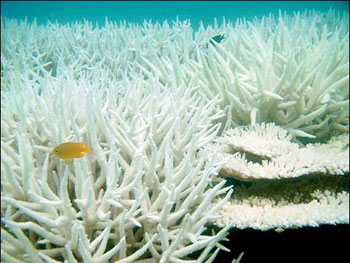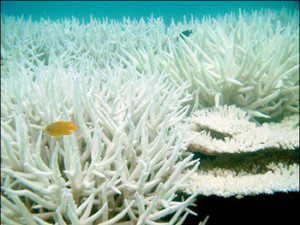Ocean Chemistry Unbalanced


Ocean acidification is a decrease in the pH of the oceans, caused by the uptake of CO2 from the atmosphere. It’s a problem; a real problem. One that marine ecologist Jane Lubchenco, head of the National Oceanic and Atmospheric Administration called global warming’s “equally evil twin.” If pH levels in the ocean continue to decline, as a consequence of the rising uptake of carbon dioxide, the very existence of coral reefs could be in jeopardy.
We hear time and time again from a plethora of news reports that coral are at risk; but other planktonic organisms, including coccolithophores, foraminifera, and pteropods, are also extremely important components of ocean ecosystems. But maybe that’s not enough motivation for people to take notice…and action. Maybe if we stated the problem in terms of how ocean acidification impacted humans, it would have more of an effect. Take for example Dr. William C.G. Burns’s article on Terrain.org:
Coastal peoples rely on the marine life found on corals for many medicinal needs, including venom from tropical cone snails that serve as a substitute for morphine, and coral skeletons that can replace bone grafts. Overall, it’s been estimated that the food, tourism revenue, coastal protection, and new medications that reefs provide are worth about $375 billion annually, with nearly 500 million people dependent on healthy coral reefs for their services.
Half a billion people depend on coral reefs? $375 billion involved? When a problem is phrased in terms of impacts to humans and the economy, action and results tend to occur. Or at least, tend to get more notice. It’s a numbers game. The right numbers get people to think. Consider the following statement from Dr. Burns’s article mentioned above:
Coral reefs are among the most diverse ecosystems in the world. While covering only 0.17 percent of the ocean floor, coral provide habitat for one quarter of all marine species.
It just doesn’t resonate with the general public. It seems the impact is not felt unless expressed in human life and dollar amounts. The need for communicating science to politicians, governing bodies and the general public could not be greater.
As amino acids are the building blocks of life… coral reefs form the framework of our coastal communities and economies and beyond.
CSIRO is hard at work on this problem. They have invested in a facility to monitor carob cycling in the Tasman Sea, part of an international observing network to detect increasing ocean acidification levels. We featured this story on an earlier edition of Australian Science back in April. You can read more about Australia’s role and how CSIRO is contributing to research and analysis on ocean acidification here. This data will help determine ocean acidification changes and how marine ecosystems might be impacted.
Burnes K (2013-11-28 07:09:22). Ocean Chemistry Unbalanced. Australian Science. Retrieved: Aug 08, 2025, from https://ozscience.com/environmental-science/ocean-chemistry-unbalanced/
 Follow
Follow
1 thought on “Ocean Chemistry Unbalanced”
Comments are closed.